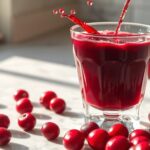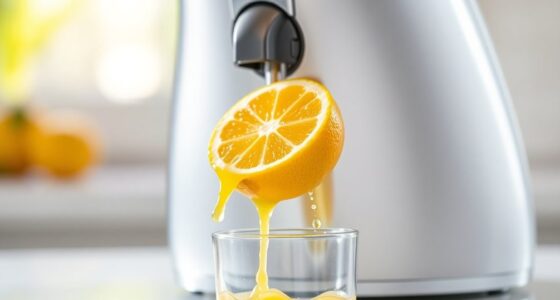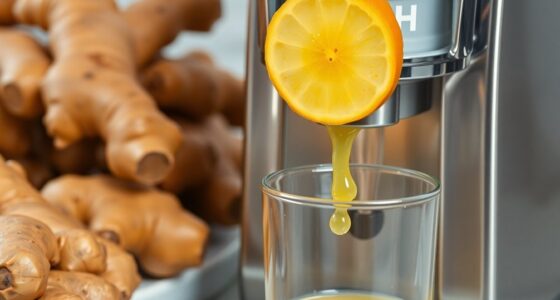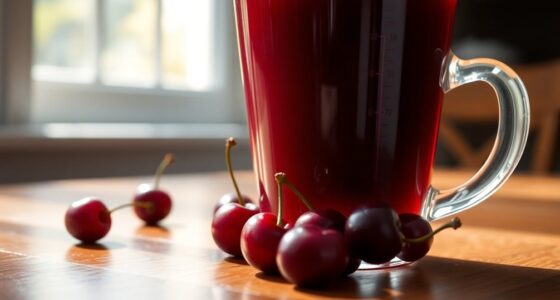To get cranberry juice out, act quickly! Blot the stain gently with a clean white cloth to absorb excess liquid. Rinse the fabric under cold water from the back to push the juice out. Mix 2/3 cup of rubbing alcohol with 1 teaspoon of liquid detergent, apply it to the stain, and let it sit for 10 to 15 minutes before blotting. For dried stains, use a vinegar and detergent mix, but be sure to test it first. There's more to learn about tackling those stains effectively!
Key Takeaways
- Blot the cranberry juice stain immediately with a clean cloth to absorb excess liquid without rubbing.
- Rinse the stained fabric from the back under cold water to push the juice out.
- Create a solution of 2/3 cup rubbing alcohol and 1 teaspoon of liquid detergent; apply it to the stain.
- For dried stains, scrape off excess, then use a vinegar and detergent mixture, gently agitating with a soft brush.
- Always test cleaning solutions on a small, inconspicuous area first to avoid discoloration or damage.
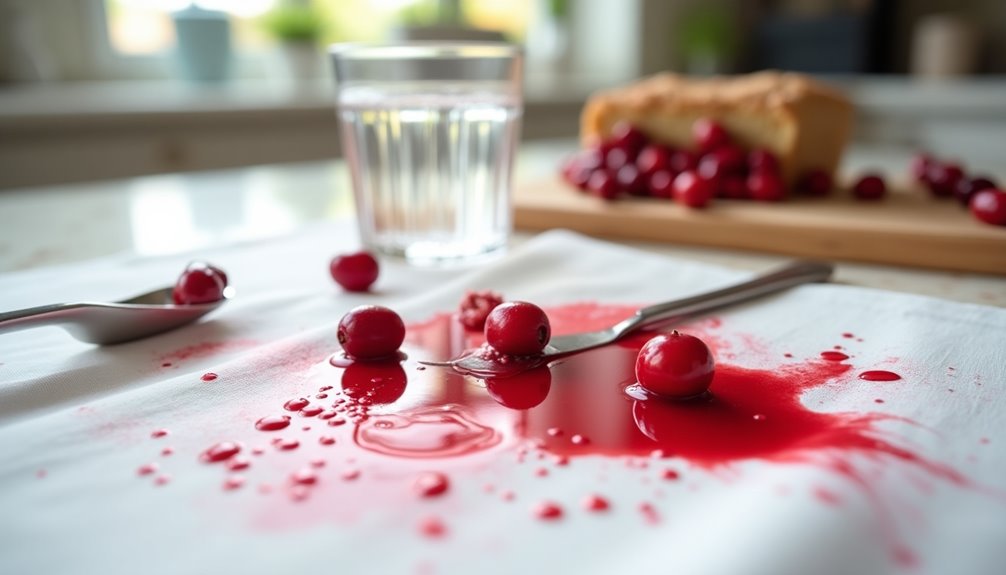
If you've ever spilled cranberry juice on your favorite shirt, you know how quickly it can stain. That bright red color can seem impossible to remove, but don't fret! With the right approach, you can tackle that stain effectively. The key is to act quickly, so let's dive into how to get that cranberry juice out of your fabric.
First things first, you need to blot the stain immediately. Grab a clean white cloth or a paper towel and gently blot the area to absorb any excess liquid. Don't rub it; that'll only push the juice deeper into the fibers. You want to prevent the stain from spreading, so be patient and let the cloth do the work.
Once you've blotted up as much juice as possible, it's time to rinse the fabric. For fresh stains, rinsing is crucial. Turn the fabric inside out and hold it under cold water. By rinsing from the back, you're pushing the cranberry juice out of the fabric rather than forcing it in deeper. This step is essential to avoid setting the stain.
If the stain is particularly stubborn, you might need to whip up a cleaning solution. To create a powerful cleaning solution, mix 2/3 cup of rubbing alcohol with 1 teaspoon of liquid detergent. Apply this mixture directly to the stain and let it sit for about 10 to 15 minutes. This waiting period allows the solution to break down the stain, making it easier to remove.
After the time is up, take a clean white cloth and gently blot the area again. You should see the stain starting to lift.
Now, if you've discovered that the cranberry juice has dried and left a mark, don't worry. You can still salvage your shirt. Start by scraping off any excess dried stains with a dull knife. Be gentle so you don't damage the fabric.
Next, you'll want to apply a mixture of vinegar and detergent to the area. This combination can effectively lift the stain, especially when you gently agitate it with a soft brush. Just be careful not to scrub too hard; you want to keep the fibers intact.
After working on the stain, rinse the fabric thoroughly under cold water to remove any cleaning solution. This step is vital to ensure no residue is left behind.
Finally, always remember to test any cleaning solution on an inconspicuous area of the fabric before applying it directly to the stain. You wouldn't want to risk discoloration or damage.
Frequently Asked Questions
Do Cranberry Juice Stains Come Out?
Yes, cranberry juice stains can come out, but you need to act quickly. The sooner you address the stain, the better your chances of removal.
Start by rinsing the area with cold water to lift some of the juice. Then, treat the stain with an enzyme-based stain remover or a heavy-duty detergent.
Just remember to test any cleaning solution on a hidden spot first to avoid discoloration. Be persistent, and you'll likely succeed!
Is Cranberry Juice Hard to Get Out of Clothes?
Oh, cranberry juice stains? They're just a walk in the park, right?
Unfortunately, they're not easy to remove from clothes. The vibrant color and stubborn tannins cling tightly to fabric, making your laundry day a bit of a nightmare.
If you don't act fast, the stain sets in. You'll want to use cold water initially and consider enzyme-based stain removers for the best chance at success.
Good luck—it might just take a miracle!
How Do You Extract Cranberry Juice?
To extract cranberry juice, start by washing fresh cranberries thoroughly.
Place them in a large pot, cover with water, and bring it to a boil.
Once the cranberries burst, simmer the mixture for about 10-15 minutes, stirring occasionally.
After that, use a fine mesh strainer or cheesecloth to separate the juice from the pulp, pressing down to get as much liquid as possible.
You can sweeten or dilute your juice to taste before using it.
How to Get Cranberry Juice Out of a White Couch?
Did you know that cranberry juice can stain fabrics in just seconds?
To tackle a cranberry juice stain on your white couch, start by blotting the area with a clean white cloth to absorb excess liquid.
Mix a solution of rubbing alcohol, vinegar, and laundry detergent, then gently blot the stain.
Rinse with cold water and blot dry.
If the stain lingers, repeat the process or consider a commercial cleaner designed for tough stains.
Conclusion
In conclusion, getting cranberry juice out isn't just about cleaning; it's like navigating a maze. Just as you need to find the right path to escape, using the right techniques helps you tackle those stubborn stains. Remember, a quick response is key—blotting immediately is like taking the first turn in a maze, guiding you toward freedom. With patience and the right tools, you can emerge victorious, leaving no trace of that vibrant red behind.
Cindy thoroughly researches juicing trends, techniques, and recipes to provide readers with practical advice and inspiration. Her writing style is accessible, engaging, and designed to make complex concepts easy to understand. Cindy’s dedication to promoting the advantages of juicing shines through her work, empowering readers to make positive changes in their lives through the simple act of juicing.






